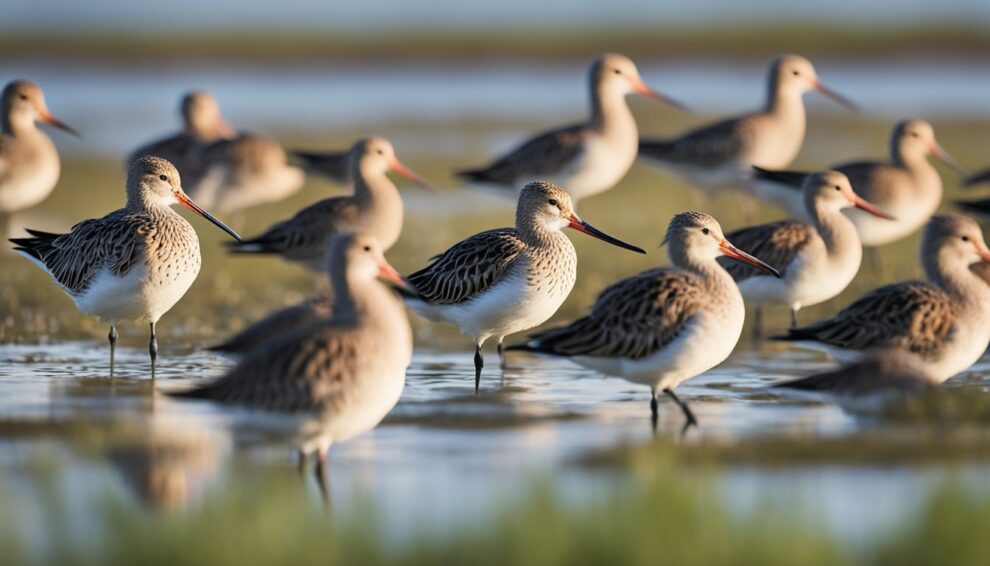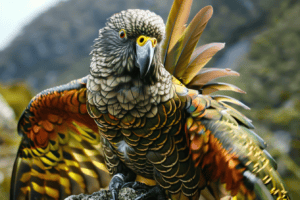Imagine a small bird, no heavier than a pair of sneakers, embarking on a jaw-dropping journey that spans thousands of miles over the open ocean, without a single stop.
That’s the spectacle of the bar-tailed godwit’s migration, a heroic feat that pushes the boundaries of endurance in the animal kingdom.
Each year, these intrepid birds traverse up to 7,200 miles in one non-stop flight from their breeding grounds in Alaska to their wintering spots in New Zealand.
Their small bodies cover immense distances, making them champions of long-distance travel.

What allows the bar-tailed godwit to navigate these epic migrations with such precision?
Scientists believe these birds have an internal compass, guided by the magnetic fields of the Earth, helping them find their way over the vast and featureless ocean.
During their voyage, their sizeable breast muscles power their wings, and their body undergoes incredible transformation, even shrinking their digestive organs to make flight more efficient.
These adaptations, along with their innate ability to read cues from the stars and landscape, ensure they reach their destination successfully.
Now, picture yourself soaring alongside the godwits, crossing continents and oceans.
Their journey is not just a record-breaking marathon; it’s a remarkable demonstration of nature’s ingenuity.
Their magnetic navigation raises questions about how such a delicate creature can accomplish what seems impossible.
As the bar-tailed godwits make their monumental migrations, they remind us of the wonders that winged travelers can achieve, defying the limits of our understanding with every flap of their wings.
Mysteries of Migration
Embarking on an incredible journey across continents, the Bar-tailed Godwit is a master of the long-haul flight, setting records that leave scientists in awe.
As these birds traverse thousands of miles, they reveal stunning aspects of migratory behavior.
The Start of a Long Journey
Every year, the Bar-tailed Godwit faces the Pacific Ocean with an amazing challenge ahead: a non-stop migration from the cozy shores of Alaska to the welcoming habitats of New Zealand.
It’s an endurance test like no other, with these avian travelers covering distances that can exceed 7,000 miles.
Imagine the planning and energy that must go into such a journey!
These birds bulk up on fat, their primary fuel source, and their muscles are fine-tuned for the long flight ahead.
Before takeoff, the Godwits feast in Alaska, storing an immense amount of energy that will sustain them across the Pacific.
Marvels of Migration Physiology
As if the distance weren’t impressive enough, the endurance physiology of the Godwit during migration is a marvel of the natural world.
As they fly non-stop, their bodies undergo remarkable changes.
Their digestive organs, no longer needed for processing food mid-journey, shrink to save precious energy and reduce weight.
Meanwhile, the heart and flight muscles grow, fortifying these birds for their continuous flapping or soaring over oceans.
This transformation illustrates the remarkable adaptability and resilience of the Godwit, and it plays a fundamental role in their ability to travel such vast distances without rest.
This perfect balance of endurance, specialized fat storage, and muscle strength is a puzzle that ornithology continually strives to understand.
Technological Wonders in Tracking

In the quest to understand the long-distance flights of Bar-tailed Godwits, scientists have employed advanced tracking technology.
This cutting-edge tech unveils the mysteries of their epic journeys and aids in their conservation.
Satellites’ Role in Ornithology
Modern ornithology has been revolutionized by satellite transmitters, tiny devices fixed to birds.
These transmitters send signals to orbiting satellites, which then relay the data back to ground stations.
This information provides scientists with details on the godwits’ location, flight altitude, and travel speed.
For instance, the U.S. Geological Survey uses this technology to track movements and migratory patterns, transforming a dot on the map into a story of survival and endurance.
Conservation through Technology
Technology not only enlightens us about these birds’ flight paths but also serves as a beacon of hope for their protection.
When scientists understand the routes the godwits traverse, they can pinpoint crucial stopover sites and breeding grounds needing conservation efforts.
This data becomes a powerful tool in advocating for habitat preservation and in drafting policies that safeguard these indispensable areas.
Consequently, the marvels of a Bar-tailed Godwit’s flight can continue to inspire and educate us, thanks to the alliance of tracking technology and conservation.
Habitats and Highways in the Sky

In their incredible journeys, Bar-tailed Godwits navigate vast distances, relying on important wetland habitats and predetermined migration routes that help them reach their destinations.
Importance of Wetlands
Wetlands are not just patches of water and mud, but vital pit-stops for Bar-tailed Godwits on their long migrations.
Imagine a network of airports where these birds can refuel and rest.
The Yellow Sea, bordered by China and Korea, serves as one of the most critical refueling sites.
Here, the godwits feast on a buffet of invertebrates, like worms, which help them regain the weight and energy lost during the initial stages of flight.
Without these wetland ‘airports’, their journey might be too arduous to complete, thereby highlighting wetlands as indispensable habitats ensuring the survival of migratory shorebirds.
Flying the Eastern Australasian Route
Have you ever wondered how birds find their way across the globe?
Bar-tailed Godwits masterfully utilize the East Asian-Australasian Flyway, which is kind of like a bird’s highway in the sky, spanning from breeding grounds in Alaska all the way to their winter home in Australia.
Scientists marvel at how precisely these shorebirds trace this flyway year after year.
They use the path formed by the geography and winds to streamline their remarkable flight, which is as efficient as it is breathtaking to observe.
The flyway guides them over different countries, such as China and Korea, turning familiar wetlands into routine stops during the arduous migration.
Each year, the regularity of this route provides them with a safe passage where they can rely on the same habitats to survive yet another epic journey.
Conserving the Bar-Tailed Godwits

The journey of the Bar-tailed Godwit is a marvel of the natural world, but their future is intricately tied to our conservation efforts.
With bird migration routes covering vast global distances, it is vital to protect these avian adventurers and their habitats at every stage of their annual cycle.
Fostering Future Flights
Ecologists and conservationists are working closely to ensure that future generations of Bar-tailed Godwits can take to the skies.
Understanding their global flyway network is crucial as it encompasses diverse geographical regions, each playing a pivotal role in their lifecycle.
Protecting these birds demands collaboration across countries and continents, as each stopover acts as a critical refueling station for the birds’ impressive migratory routes.
From the food-rich tidal flats where they fatten up to the secure nesting grounds, every habitat is safeguarded with the future in mind.
Did you know that these godwits can fly non-stop for thousands of kilometers over the ocean?
Imagine preparing for a trip where you couldn’t stop for a snack or a rest for days on end!
That’s what these intrepid travelers do, making habitat conservation along their route not just helpful but essential for their survival.
Global Efforts and Local Actions
Conservation efforts for the Bar-tailed Godwit are as vast as the distances these birds cover.
At the grassroots level, local communities are educated about the importance of maintaining bird-friendly environments. But it doesn’t stop there.
Internationally, agreements between countries aim to preserve critical resting and feeding sites.
These subspecies of godwits face threats such as climate change and habitat loss, but with concerted global strategies and the engagement of local stakeholders, their numbers can be maintained or even increased.
How would you feel if your favorite pit stop on a long road trip suddenly disappeared?
It’s the same for these birds when their stopover sites are threatened.
That’s why the actions of every single person along their path can make a big difference in the population size of Bar-tailed Godwits.
When we look at the whole picture, from conserving mudflats to fighting climate change, we are not just helping these birds; we’re preserving the beautiful balance of our planet’s ecosystems.
Frequently Asked Questions

Bar-tailed godwits undertake one of the most awe-inspiring migrations in the animal kingdom, navigating across vast distances with remarkable precision.
This section answers some of the most intriguing questions about their journeys and the exceptional abilities they possess.
How do bar-tailed godwits sense the Earth’s magnetic field during migration?
Bar-tailed godwits have an internal compass that allows them to detect the Earth’s magnetic field, a sense known as magnetoreception.
They use this ability to maintain orientation and direction over the open ocean and featureless landscapes during their long migrations.
What triggers the bar-tailed godwit to start its migratory journey each year?
The migration of bar-tailed godwits is triggered by a combination of factors including changes in day length, falling temperatures, and an innate genetic predisposition.
These signals tell them it’s time to embark on their epic journey.
Which specific cues in the environment influence the directional decisions of bar-tailed godwits during long flights?
Bar-tailed godwits rely on environmental cues like the position of the sun, the stars at night, and the Earth’s magnetic field to guide them.
They may also use visual landmarks when flying over land to adjust their flight paths.
Can you describe the challenges bar-tailed godwits face while traveling such long distances?
Travelling such immense distances, bar-tailed godwits encounter multiple challenges including extreme weather, predation risks, and the need to navigate with precision.
The loss of critical stopover sites due to habitat destruction also poses a significant threat to their journey.
How does the bar-tailed godwit’s body adapt to the demands of non-stop flight during migration?
During non-stop flights, a bar-tailed godwit’s body undergoes extraordinary changes.
Its digestive organs shrink while its heart and flight muscles enlarge to support the strenuous activity.
Fat reserves are also built up as fuel for the energy-intensive journey.
In what ways do scientists study and track the migratory patterns of bar-tailed godwits?
Scientists study bar-tailed godwits by fitting them with lightweight satellite transmitters or geolocators to track their movements.
These devices provide invaluable data on their flight routes, stopover sites, and the incredible distances they cover.









